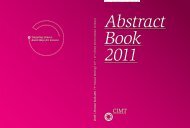Abstract Book 2010 - CIMT Annual Meeting
Abstract Book 2010 - CIMT Annual Meeting
Abstract Book 2010 - CIMT Annual Meeting
Create successful ePaper yourself
Turn your PDF publications into a flip-book with our unique Google optimized e-Paper software.
009 Kuhn | Therapeutic vaccination<br />
Phosphorothioate cap analogs increase stability and translational<br />
efficiency of RNA vaccines in immature dendritic cells and<br />
induce superior immune responses in vivo<br />
Andreas N. Kuhn 1 , Mustafa Diken 1 , Sebastian Kreiter 1 , Abderraouf Selmi 1 , Joanna Kowalska 2 ,<br />
Jacek Jemielity 2 , Edward Darzynkiewicz 2 , Christoph Huber 1 , Özlem Türeci 1 , and Ugur Sahin 1<br />
1 Department of Internal Medicine III, Division of Translational and Experimental Oncology,<br />
University Medicine Mainz, Germany<br />
2 Division of Biophysics, Institute of Experimental Physics, Faculty of Physics, University of Warsaw, Poland<br />
Vaccination with in vitro transcribed RNA coding<br />
for tumor antigens is considered a promising approach<br />
for cancer immunotherapy and has already<br />
entered human clinical testing.<br />
One of the basic objectives for development of RNA<br />
as a vaccine is the optimization of immunobioavailability<br />
of the encoded antigen in vivo. In previous<br />
work, we have developed plasmid templates<br />
for in vitro transcription of RNA-encoded antigens<br />
with modified 3‘ structures (3‘ UTR and poly(A)tail)<br />
stabilizing the RNA and optimizing its translational<br />
performance in dendritic cells (DCs), the<br />
major antigen-presenting cells (1). Moreover, we<br />
achieved significant leverage of MHC class I and II<br />
presentation of the antigen in DCs by introducing<br />
routing signals (2). By combining these measures<br />
we were able to profoundly improve properties of<br />
RNA-encoded vaccines.<br />
Yet another important structural element of in vitro<br />
transcribed RNA is the 5‘ cap structure. Capping of<br />
in vitro synthesized RNA is achieved by transcribing<br />
the DNA template in the presence of the cap<br />
dinucleotide m7GpppG as structural homolog of the<br />
endogenous cap structure. Recently, several synthetic<br />
cap analogs have been described with modifications<br />
that influence stability and translational<br />
characteristics of the respective RNA species.<br />
Up to now, such modified cap analogs have been<br />
primarily employed to study RNA metabolism.<br />
Their impact, however, on bioavailability of the<br />
encoded protein in antigen presenting cells such<br />
as DCs and eventually on induction of potent T-cell<br />
responses in vivo has never been investigated. Therefore<br />
we have preclinically evaluated novel cap<br />
analogs for immunopharmacological improvement<br />
of vaccines based on antigen-encoding RNA. We<br />
demonstrate that RNAs capped with the D1 diastereoisomer<br />
of m27,2‘-OGppSpG (beta-S-ARCA) have<br />
increased stability and translational efficiency in<br />
immature but not mature DCs. Accordingly, in vivo<br />
delivery of the antigen as beta-S-ARCA(D1)-capped<br />
RNA species led to increased protein expression<br />
and enhanced priming and expansion of naïve antigen-specific<br />
T-cells in mice. We expect that our<br />
findings pave the way for inauguration of modified<br />
cap analogs into RNA vaccine development and<br />
will likely contribute to a better clinical outcome.<br />
(1) Holtkamp et al. (2006) Blood 108: 4009-17<br />
(2) Kreiter et al. (2008) J Immunol 180: 309-18<br />
45



